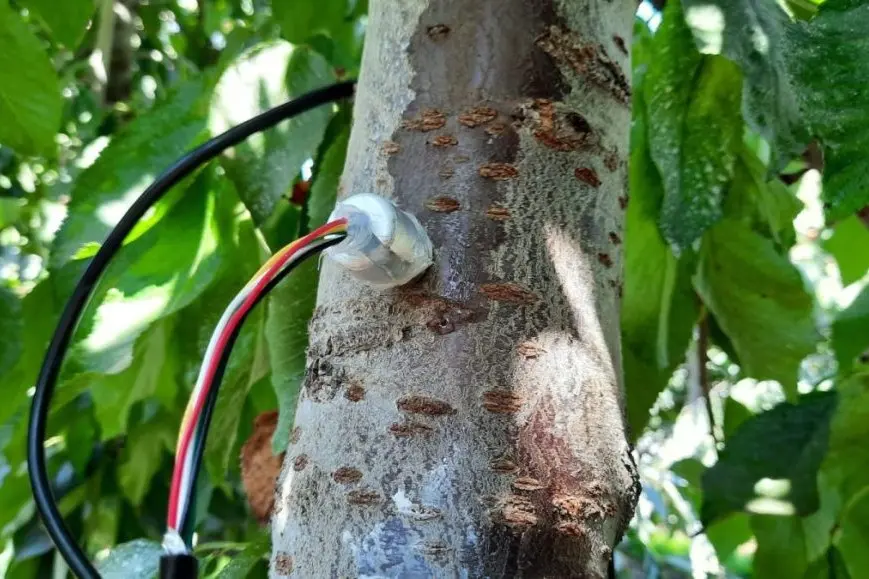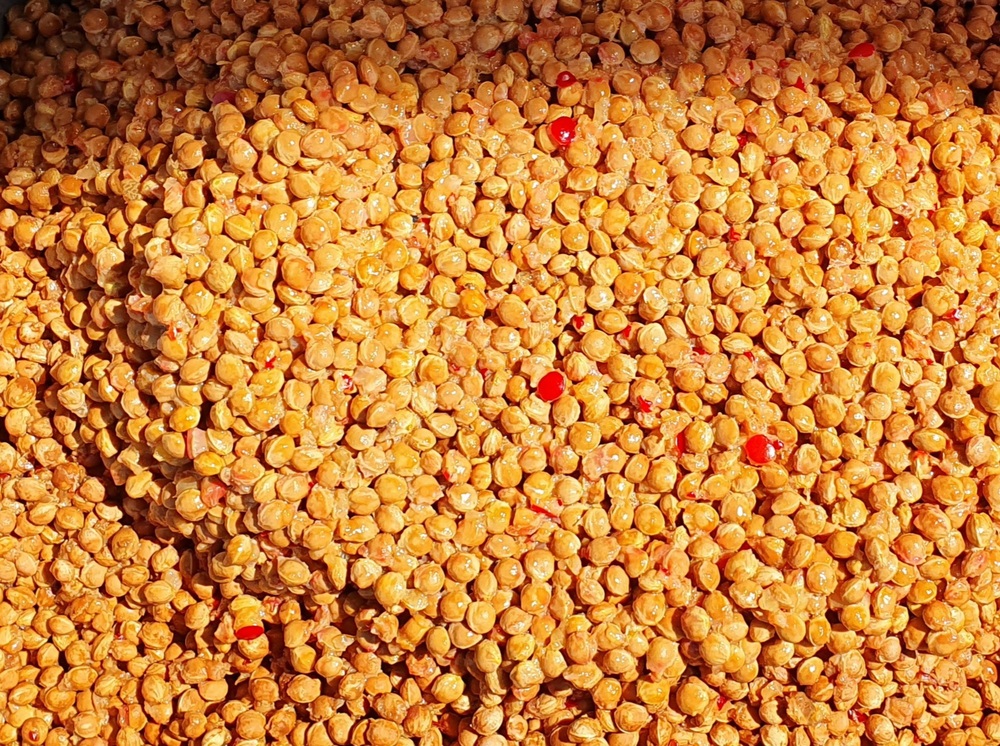A changing climate has cherry scientists all over the world working on ways to adapt.
Low-chill cultivars, netting in winter and a species that thrives in warm, humid areas were among potential solutions floated in early June as cherry experts from 20 countries converged in Richland, Washington, for the 10th International Cherry Symposium, organized by the International Society for Horticultural Science and held every four years in different locations across the globe.
“We must deal with these projections, with these climate conditions,” said Berta Gonçalves of the University of Trás-os-Montes and Alto Douro in Portugal, one of the four-day event’s keynote speakers.
The symposium, which also included talks on plant growth regulators and technology, featured science presentations and an orchard tour.
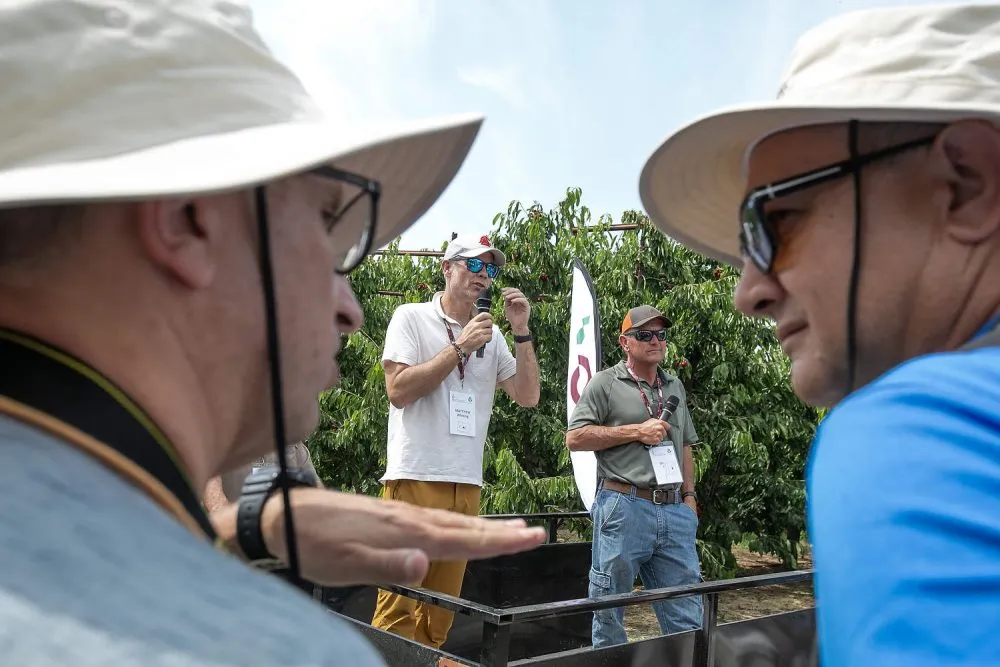 Researchers Miljan Cvetkovic of Bosnia, far left, and Milutin Karas of Serbia, far right, translate for each other as they listen to Matt Whiting of Washington State University, speaking, and grower Shawn Gay discuss farming strategies in June at the 10th International Cherry Symposium tour through South Central Washington. (TJ Mullinax/Good Fruit Grower)
Researchers Miljan Cvetkovic of Bosnia, far left, and Milutin Karas of Serbia, far right, translate for each other as they listen to Matt Whiting of Washington State University, speaking, and grower Shawn Gay discuss farming strategies in June at the 10th International Cherry Symposium tour through South Central Washington. (TJ Mullinax/Good Fruit Grower)
Solutions and experimentation
In Portugal, breeders are looking for cultivars that require few winter chill units, as well as those that resist frost damage and rain cracking, Gonçalves said.
Growers are experimenting with humic acid, fulvic acids and seaweed extract, concluding they boost fruit nutrition, firmness and crack prevention.
Likewise, Francisco Maldonado with Corteva Agriscience in Chile discussed promising results from heat stress trials of salicylic acid and abscisic acid.
In Israel, researchers at the MIGAL Galilee Research Institute have used black netting over cherries to extend winter dormancy, boosting chilling hours by 27 percent, said Michal Ackerman-Lavert.
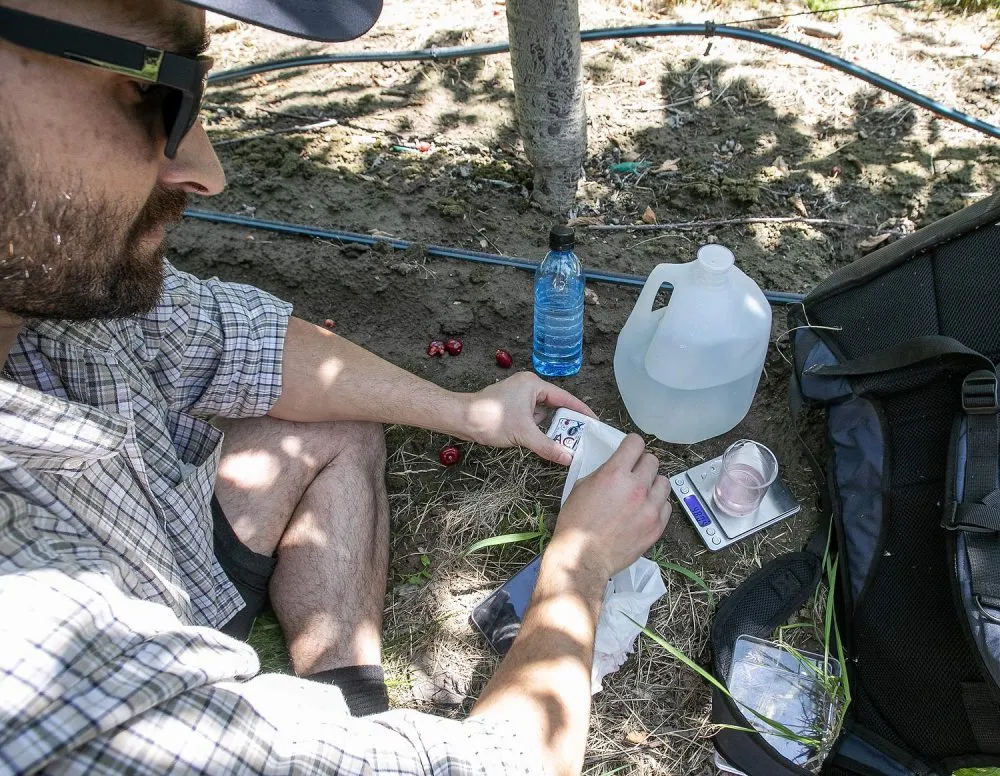 Eric Muller, a researcher from Chile, tests Brix during a tour stop. (TJ Mullinax/Good Fruit Grower)
Eric Muller, a researcher from Chile, tests Brix during a tour stop. (TJ Mullinax/Good Fruit Grower)
Coverings and cultivars
Bud temperatures went down and yields went up during the two years of trials, which they have repeated on apricots, peaches and pears.
Similar net configurations are in trials and on commercial orchards in California.
In Chile, growers and researchers are learning more about coverings, said Marlene Ayala of Pontifical Catholic University of Chile.
In her trials, high-tunnel and self-ventilating systems advance maturity by a week, but she finds reduced firmness high in the canopy without ventilation.
Covered blocks also show higher vegetative growth, lower water demand and bigger fruit.
In the warm, humid regions of China’s southern provinces, the cherry industry is covering cherries, said Caixi Zhang of Shanghai Jiao Tong University.
In Liaoning province, 34 percent of the cherry crop is grown under coverings but generates 70 percent of the crop’s value.
The university has used a different cherry species — the Chinese cherry, or Prunus pseudocerasus — in breeding low-chill varieties.
Models and future projections
The sweet cherry is Prunus avium.
Several speakers shared models under development to help growers navigate climate shifts.
University of California, Davis, scientists are working on an estimation model called “TreeChill” that accounts for tree tissue temperature, which often exceeds air temperature and skews chill accumulation down by 15 percent.
They intend to add carbohydrate development data and release TreeChill on Shiny applications (shinyapps.io).
Eike Luedeling of the University of Bonn in Germany discussed a computer model that shows a future with earlier bloom dates and increasing spring frost risk.
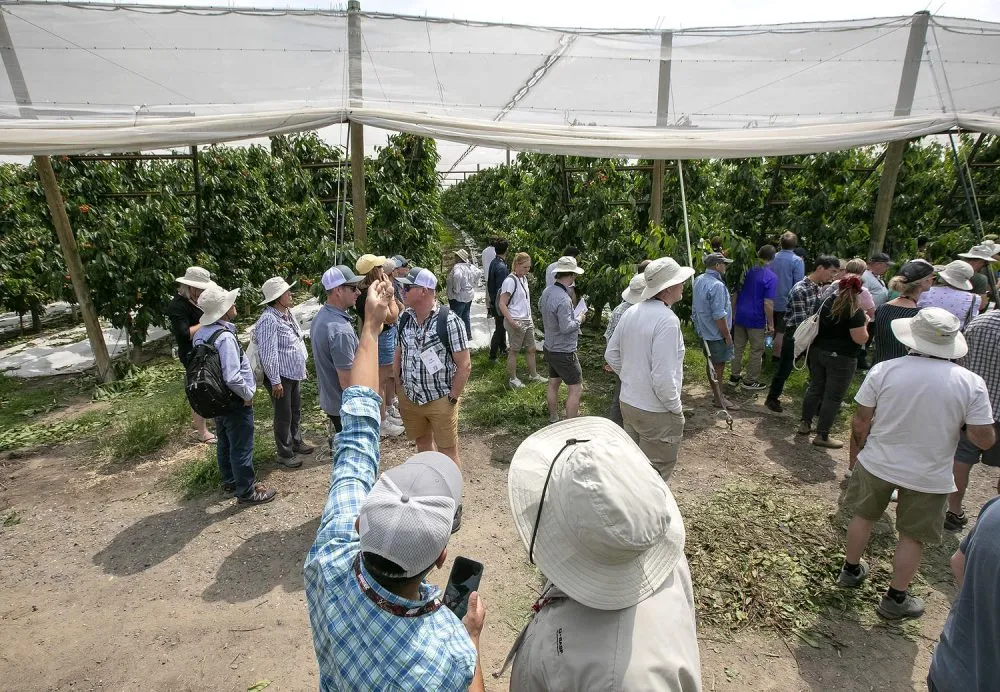 Two attendees of the cherry tour check out netting at a Rainier block near Pasco. Finley Cherries uses netting mostly to protect bruise-sensitive varieties from wind, but the nets also provide shade when needed. (TJ Mullinax/Good Fruit Grower)
Two attendees of the cherry tour check out netting at a Rainier block near Pasco. Finley Cherries uses netting mostly to protect bruise-sensitive varieties from wind, but the nets also provide shade when needed. (TJ Mullinax/Good Fruit Grower)
The PGR puzzle
Cherry growers around the world use gibberellic acid (GA3) to increase fruit size and firmness, but the fact that it also delays maturity for several days can be an asset or a detriment, depending on the region and desired market window.
In Tasmania, Australia, where growers see the delay as a tool to help them time harvest for Chinese New Year, Dugald Close ran trials comparing a grower standard rate of GA3 at 44 parts per million to a double rate of 88 ppm on Lapins.
The standard rate delays harvest four days, but the double rate delayed it 11 days, with increased fruit firmness and weight but no size difference.
“It’s a denser, heavier fruit for a given size,” said Close, a professor with the University of Tasmania. “It’s punching above its weight.”
In California, however, growers want the firmness benefit without the delay drawback.
“Earliness is everything in California,” said Jozsef Racsko of Valent USA, introducing research trials that looked at the effect of following GA3 with abscisic acid, or ABA, a major regulator of ripening in non-climacteric fruits.
Yes, ABA is often used as a chemical thinner, but not at the rates used in this trial, he said.
“Foliar application of ABA seems to increase color development and speed up the maturation process,” he said.
And it shows no negative effects on fruit size or firmness — if you control for harvest timing.
Pick the ABA-treated fruit on the same day the control fruit is ripe — which is two to four days ahead — and the cherries will be overripe and less firm.
Gabriel Torres-Londono of Suntton International Inc. introduced another product that seems to balance out the effect of GA3: A plant hormone precursor known as 24-epibrassinolide shows promise in offsetting the color development delay.
Every cultivar responds a little differently to the compound, marketed as Sunergist, but multiyear studies in Lodi, California, Bing orchards showed that it can help growers harvest seven to 11 days earlier than fruit treated with GA3 alone, and it can push more fruit into a higher-value color range, he said.
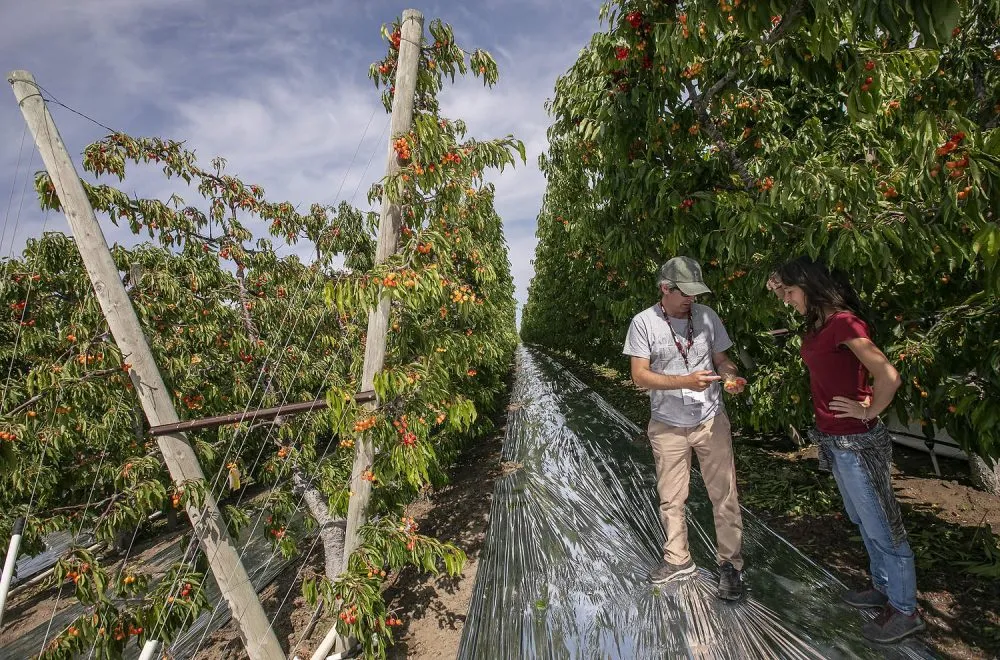 Researchers José Quero Garcia of the French National Institute for Agriculture, Food and Environment, and Paula Guzman-Delgado of University of California, Davis, discuss a formally trained Tatura block of Early Robin cherries. (TJ Mullinax/Good Fruit Grower)
Researchers José Quero Garcia of the French National Institute for Agriculture, Food and Environment, and Paula Guzman-Delgado of University of California, Davis, discuss a formally trained Tatura block of Early Robin cherries. (TJ Mullinax/Good Fruit Grower)
Tour stops and orchard systems
Two attendees of the cherry tour check out netting at a Rainier block near Pasco.
Finley Cherries uses netting mostly to protect bruise-sensitive varieties from wind, but the nets also provide shade when needed. (TJ Mullinax/Good Fruit Grower)
The tour stopped at five orchards on a variety of systems, with visitors from warmer climates asking questions about chilling hours, of which Central Washington gets plenty.
Frost and rain are bigger concerns, said Keith Oliver, manager of Olsen Bros. Ranches near Benton City.
His farm uses wind machines, orchard heaters and under-canopy irrigation against spring frost.
Some years he hires a helicopter pilot on retainer to dry rain-soaked cherries, but this year budgets didn’t allow, he said.
“We’re taking chances,” he said.
At nearby River Valley Fruit, Don Olmstead III has a trial of vented Voen rain and hail coverings.
Olmstead’s panels connect with zippers, but an alternate design with breakaway clips lets accumulated ice fall harmlessly in the drive row, not on trees.
Olmstead is considering covering his crack-sensitive Santina cherries, which grow large and plentiful, he said, but “they smell rain, and they crack.”
As for systems, Olsen Bros. uses a UFO V-trellis.
It’s expensive to start, Oliver said, but it is high-yielding across varieties, easy to teach to pruning crews and attractive to pickers.
Tech innovation and mechanization
Hayden Farms in Pasco hosted the tour in a block of Early Robin cherries on a formal Tatura V-trellis with fruiting branches trained laterally.
And at Finley Cherries, grower Shawn Gay showed a similar system for his Rainiers, covered by netting to prevent wind bruising.
Gay grows red cherries on less formal systems of three or four leaders, with the lowest wire at 6 feet — allowing pickers to duck under it.
Another highlight of the conference was a look at how cherry orchard systems have advanced over the decades, shared by two professors emeritus, Greg Lang and Lynn Long.
Future innovations in systems will be built around the basic science of light interception and the ratio of leaf to fruit area cherries need for optimum quality, Lang said.
“Think about your trees as solar panels, how do you want to put them out to efficiently capture light?” Lang said.
Speaking of light panels, Zhang of Shanghai Jiao Tong University spoke of research into supplemental lighting for the greenhouse cherries that are a growing sector of Chinese production.
He found that low-dose laser lights promote plant growth better, and with less energy consumption, than LEDs.
Meanwhile, in Germany, Martin Penzel is working to use data collected by the lidar sensors on smart sprayers to generate horticultural data researchers need to collect in a wide variety of trials, such as trunk diameter, shoot length, branch angle and leaf area.
As for mechanized management, Brent Black of Utah State University shared findings from a trial looking at hedging of high-density tart cherry trees.
He found that a three-year cycle of hedging for renewal was just as effective as consistent hedging every year.
But overall, while moving to high-density offered early production, the standard spacing outperformed the high-density system over the long term.
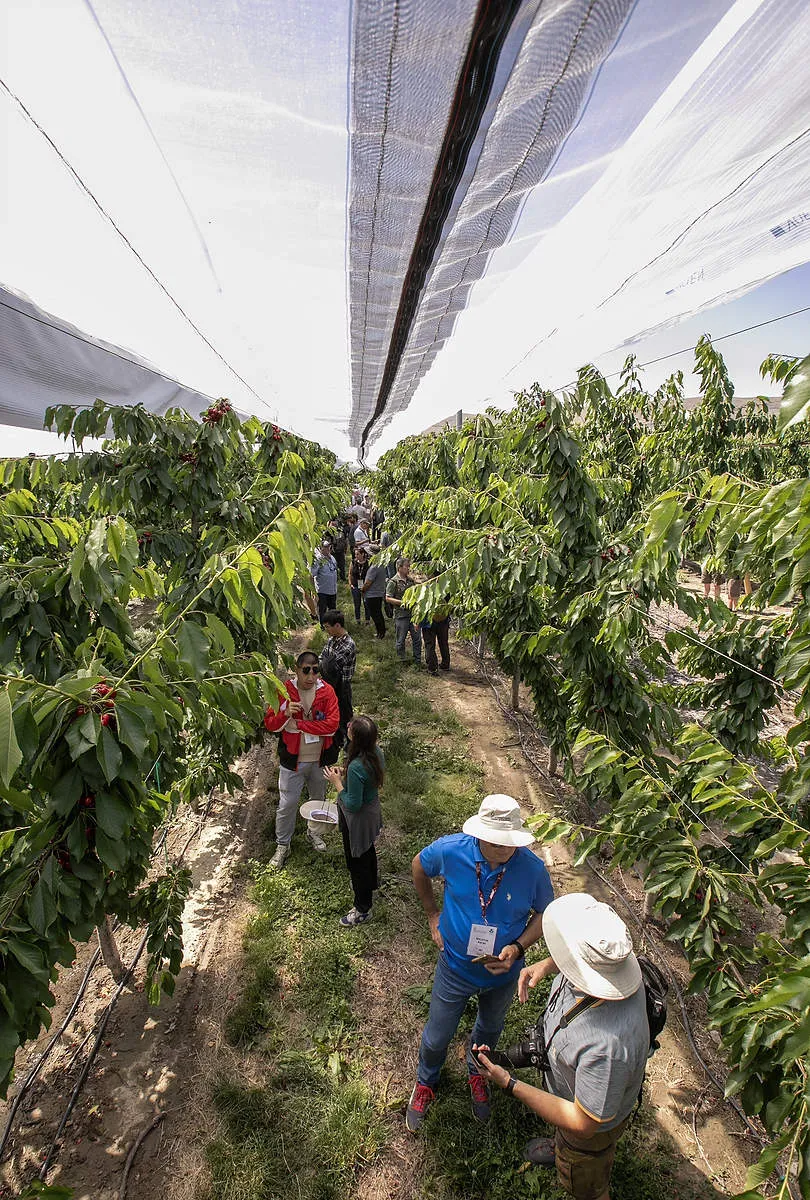 Ventilated rain and hail netting from Germany’s Voen Covering Systems was on display at River Valley Fruit. (TJ Mullinax/Good Fruit Grower)
Ventilated rain and hail netting from Germany’s Voen Covering Systems was on display at River Valley Fruit. (TJ Mullinax/Good Fruit Grower)
Matt Whiting of Washington State University, who served as convener for the meeting, shared his experiences developing a mechanical cherry harvest system pairing a handheld device that shakes one limb at a time with a soft catch frame held below each branch.
Using that shake-and-catch system, which requires far less energy than a tart cherry or nut shaker, Whiting and his student picked 50 percent faster than professional crews, on a per-person basis, he said, showing the potential of the approach.
“The challenge is in canopy management and continuing education of the potential — and I would argue, essential — need to move to stem-free cherries,” he said.
Consumer studies have found favorable responses to stemless cherries, but produce buyers often see the stem as a sign of quality, Whiting said.
Studies in France have found the same thing — consumer support but retail roadblocks — a member of the audience chimed in.
Opening image source: Zach Mazur, WSU
Ross Courtney e Kate Prengaman
Good Fruit Grower
Cherry Times - All rights reserved









